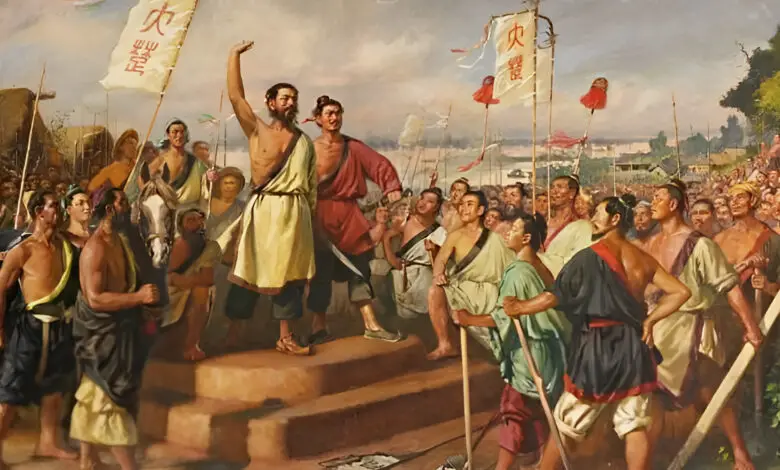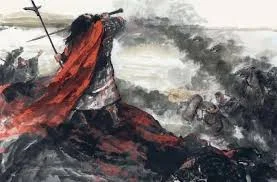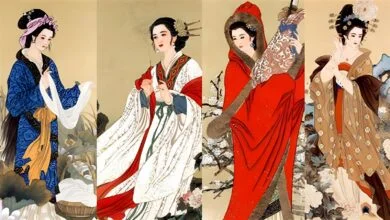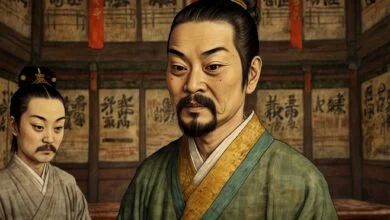
Table of Contents
Introduction
The Qin Dynasty (221–206 BC) is a pivotal period in Chinese history, marked by the unification of China under Qin Shi Huang and the establishment of centralized imperial rule. However, this era is equally notable for the massive peasant uprising that occurred towards its end, known as the Qin Peasant Rebellion. This uprising, initiated by Chen Sheng and Wu Guang, represents the first large-scale peasant rebellion in Chinese history. The rebellion not only signaled widespread dissatisfaction with the Qin regime but also catalyzed the eventual downfall of the dynasty and the emergence of new power dynamics in ancient China.
The Context: Qin Dynasty’s Reign
Under the leadership of Qin Shi Huang, the Qin Dynasty undertook several monumental projects and reforms aimed at consolidating power and unifying China. These included the construction of the Great Wall, a national road network, and the emperor’s elaborate mausoleum. Moreover, the regime imposed standardized measurements, weights, and even scripts to unify the diverse regions under a centralized government.
While these measures brought about administrative efficiency and cultural unification, they also imposed a heavy burden on the population. The empire’s ambitious construction projects required vast amounts of labor, often conscripted from the peasantry. Additionally, the military campaigns against the mongols to the north and the southern Yue tribes drained the state’s resources and further increased the burdens on the people. Harsh laws and severe punishments exacerbated the public’s suffering, creating a climate ripe for rebellion.
The Catalysts: Oppression and Injustice
The oppressive policies of the Qin Dynasty, particularly the harsh legal system known as «Qin law,» played a critical role in fueling public resentment. This legal system was characterized by extremely severe punishments for even minor infractions, which fostered widespread fear and discontent among the populace. The imposition of heavy taxes and forced labor further strained the livelihoods of commoners, especially the peasantry, who were the backbone of the state’s economy.
A particularly draconian aspect of Qin law was the punishment for late arrivals of conscripted soldiers to their posts, which was death. This regulation became a direct trigger for the uprising when, in 209 BC, a group of conscripts led by Chen Sheng and Wu Guang were delayed due to heavy rains while en route to the northern frontier at Yuyang. Facing certain execution for their delay, Chen Sheng and Wu Guang decided to revolt against the Qin authorities, thus sparking the first major peasant rebellion in Chinese history.
The Outbreak: The Daze Village Uprising
The rebellion began in Daze Village (present-day Anhui Province) when Chen Sheng and Wu Guang, realizing the futility of adhering to the oppressive laws, declared their rebellion. Their famous proclamation, «Are kings and nobles born to be such?» questioned the legitimacy of hereditary rule and resonated deeply with the oppressed masses. This rallying cry highlighted the universal human desire for equality and justice, galvanizing widespread support for the rebellion.
The rebels quickly gathered momentum, with Chen Sheng being proclaimed king and establishing a short-lived regime called Zhang Chu. This new government, based in Chen County (modern Huaiyang, Henan Province), attracted thousands of followers, including other dissatisfied elements of society such as local gentry and disgruntled officials. The uprising was not just a spontaneous outburst of anger but was also a well-organized movement with clear political goals, including the overthrow of the Qin Dynasty and the establishment of a new, more just order.
Expansion and Challenges: The Spread of the Rebellion
The initial success of the rebellion at Daze Village inspired numerous other revolts throughout the Qin Empire. The rebels managed to capture significant territories and garnered considerable support from the population. This widespread participation indicated deep-seated dissatisfaction with the Qin regime across various strata of society.
However, the movement also faced significant challenges. While Chen Sheng was a capable leader, he struggled with internal dissent and the logistical difficulties of managing a rapidly expanding movement. Moreover, the Qin Dynasty, despite being weakened, was not defenseless. It responded with a combination of military force and strategic concessions, attempting to quell the uprising through both coercion and co-optation.
The rebellion’s expansion also faced challenges from within. The rapid growth of the rebel forces led to logistical issues, and maintaining discipline among the troops became increasingly difficult. Furthermore, Chen Sheng’s leadership style and decisions began to alienate some of his key supporters. His declaration of kingship, for instance, was seen by some as premature and hubristic, undermining the unity and morale of the rebel forces.
The Role of Key Figures: Chen Sheng and Wu Guang
Chen Sheng and Wu Guang, the initial leaders of the rebellion, played crucial roles in shaping the movement’s trajectory. Chen Sheng, who was initially a commoner conscripted for military service, demonstrated remarkable leadership skills and political acumen. His decision to revolt was both bold and strategic, capitalizing on the widespread discontent and the vulnerability of the Qin state.
Wu Guang, on the other hand, was instrumental in organizing the rebel forces and coordinating their military actions. Together, they formed a formidable leadership duo, capable of inspiring and mobilizing the masses. However, their partnership was not without its challenges. Differences in vision and strategy occasionally surfaced, reflecting the broader difficulties of maintaining cohesion in a large and diverse revolutionary movement.
Despite these challenges, the leadership of Chen Sheng and Wu Guang was characterized by a pragmatic approach to governance. They sought to legitimize their rule by invoking the names of respected figures such as Fusu, the deceased Qin crown prince, and the Chu general Xiang Yan. This strategy aimed to rally support from both the common people and disaffected members of the elite, thereby broadening the base of the rebellion.
The Turning Point: Suppression by Qin Forces
The initial successes of the rebellion were met with a fierce response from the Qin government. General Zhang Han, one of the most capable Qin military leaders, was dispatched to suppress the uprising. Zhang Han’s counter-offensive was swift and brutal, targeting key rebel strongholds and employing both military might and psychological warfare to demoralize the rebels.
The Qin forces gradually regained control over the territories captured by the rebels. A decisive moment came when Chen Sheng, who had become increasingly isolated and paranoid, was betrayed and killed by his own followers. This marked the beginning of the end for the Zhang Chu regime, as the rebellion lost its central leadership and strategic direction.
The suppression of the rebellion was not merely a military victory for the Qin Dynasty but also a psychological one. The defeat of the rebels shattered the illusion of invincibility that had surrounded the uprising, leading to defections and diminishing support. However, the harsh measures employed by the Qin in suppressing the rebellion only further alienated the population, setting the stage for further uprisings.
The Emergence of Xiang Yu and Liu Bang
While the suppression of the Zhang Chu regime marked a temporary setback for the anti-Qin forces, it also paved the way for new leaders to emerge. Among these, Xiang Yu and Liu Bang stood out as the most prominent and capable. Both were regional leaders who initially supported the rebellion but eventually carved out their own independent power bases.
Xiang Yu, known for his exceptional military prowess, quickly became a central figure in the anti-Qin struggle. His decisive victories, including the famous Battle of Julu, where he defeated a much larger Qin force, established him as a formidable leader. However, Xiang Yu’s leadership style was often seen as overly harsh and autocratic, which limited his appeal to other rebel leaders and the broader population.
Liu Bang, in contrast, adopted a more pragmatic and conciliatory approach. As a former peasant himself, Liu Bang was able to connect with the common people and present himself as a more relatable and less authoritarian leader. His strategy of co-opting former Qin officials and local elites into his administration also helped to stabilize his rule and expand his base of support.
The Fall of the Qin Dynasty
The efforts of Xiang Yu and Liu Bang, along with other regional leaders, eventually culminated in the fall of the Qin Dynasty. Liu Bang’s forces captured the Qin capital, Xianyang, effectively ending Qin rule and marking the beginning of a new era in Chinese history. The death of the last Qin emperor, Ziying, symbolized the complete collapse of the Qin state.
However, the fall of the Qin did not lead to immediate stability. The power vacuum left by the dynasty’s collapse led to a period of intense conflict known as the Chu-Han Contention, where Xiang Yu and Liu Bang competed for dominance. This period of strife eventually ended with Liu Bang’s victory and the establishment of the Han Dynasty, which would go on to become one of China’s most enduring and influential dynasties.

Conclusion: Legacy and Impact
The peasant uprising at the end of the Qin Dynasty had far-reaching consequences for Chinese history. Although the initial rebellion led by Chen Sheng and Wu Guang was ultimately unsuccessful, it set in motion a chain of events that led to the collapse of the Qin Dynasty and the rise of the Han Dynasty. The rebellion also highlighted the deep-seated issues within the Qin state’s policies, particularly its harsh legal system and heavy burdens on the populace.
Moreover, the uprising demonstrated the potential power of peasant movements in Chinese history, foreshadowing future rebellions that would similarly challenge established orders. It also underscored the importance of leadership and strategic vision in revolutionary movements, as seen in the contrasting fates of Chen Sheng and Liu Bang.
In the broader context of Chinese history, the Qin Peasant Rebellion stands as a testament to the enduring tension between centralized power and local autonomy, as well as the potential for social and political change driven by popular movements. Its legacy is a reminder of the cyclical nature of Chinese dynastic history, where periods of consolidation and centralization are often followed by periods of fragmentation and rebellion.


